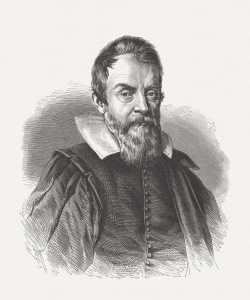His pioneering achievements in the field of astronomy laid the basis for the wonderful discoveries we are making about the universe today…

Jupiter, we now know, has many moons. Several dozen at least. Probably many more. How many there are exactly is anybody’s guess – it depends what you mean by ‘moon’ and (more importantly) how much time and effort you want to spend trying to count them. But there are four big ones: Io, Europa, Ganymede and Callisto. Collectively, these are known as the ‘Galilean Moons’, because they were discovered by the Italian polymath Galileo Galilei.
Saturn, the next planet out from Jupiter, and the second largest in our Solar System, is famous for its ring system – which, again, was discovered by Galileo Galilei (though he never quite worked out what it was he was looking at there).
He didn’t discover Jupiter or Saturn, of course. You did that, the last time you looked up at the sky in the evening or the morning. And he didn’t invent the telescope either. (We don’t really know who that was, but it wasn’t Galileo – though he did build his own from scratch.)
But he was the first person to systematically use a telescope to study the planets. And what he found, most significantly, was that not every celestial body orbits the Sun or the Earth. Which lent credence to Copernicus’s radical new theory that the Earth went round the Sun, and not vice versa… which earned Galileo a dotage under house arrest for heresy!
